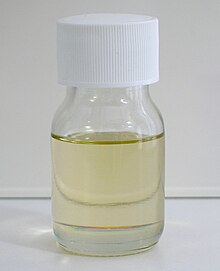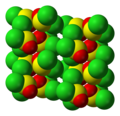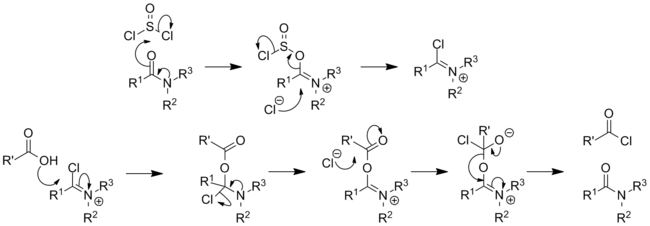Thionyl chloride

| |

| |

| |
| Names | |
|---|---|
| IUPAC name
Thionyl chloride
| |
Other names
| |
| Identifiers | |
3D model (
JSmol ) |
|
| ChEBI | |
| ChemSpider | |
ECHA InfoCard
|
100.028.863 |
| EC Number |
|
PubChem CID
|
|
RTECS number
|
|
| UNII | |
| UN number | 1836 |
CompTox Dashboard (EPA)
|
|
| |
| |
| Properties | |
| SOCl2 | |
| Molar mass | 118.97 g/mol |
| Appearance | Colourless liquid (yellows on ageing) |
| Odor | Pungent and unpleasant |
| Density | 1.638 g/cm3, liquid |
| Melting point | −104.5 °C (−156.1 °F; 168.7 K) |
| Boiling point | 74.6 °C (166.3 °F; 347.8 K) |
| Reacts | |
| Solubility | Soluble in most aprotic solvents: toluene, chloroform, diethyl ether. Reacts with protic solvents such as alcohols |
| Vapor pressure |
|
Refractive index (nD)
|
1.517 (20 °C)[2] |
| Viscosity | 0.6 cP |
| Structure | |
| pyramidal | |
| 1.44 D | |
| Thermochemistry | |
Heat capacity (C)
|
121.0 J/mol (liquid)[3] |
Std molar
entropy (S⦵298) |
309.8 kJ/mol (gas)[3] |
Std enthalpy of (ΔfH⦵298)formation |
−245.6 kJ/mol (liquid)[3] |
| Hazards | |
| Occupational safety and health (OHS/OSH): | |
Main hazards
|
Very toxic, corrosive, releases HCl on contact with water |
| GHS labelling: | |
  
| |
| Danger | |
| H302, H314, H331 | |
| P261, P280, P305+P351+P338, P310 | |
| NFPA 704 (fire diamond) | |
| Flash point | Non-flammable |
| NIOSH (US health exposure limits): | |
PEL (Permissible)
|
None[4] |
REL (Recommended)
|
C 1 ppm (5 mg/m3)[4] |
IDLH (Immediate danger) |
N.D.[4] |
| Related compounds | |
Related Thionyl halides
|
|
Related compounds
|
|
Except where otherwise noted, data are given for materials in their standard state (at 25 °C [77 °F], 100 kPa).
| |
Thionyl chloride is an
Thionyl chloride is sometimes confused with sulfuryl chloride, SO2Cl2, but the properties of these compounds differ significantly. Sulfuryl chloride is a source of chlorine whereas thionyl chloride is a source of chloride ions.
Production
The major industrial synthesis involves the reaction of sulfur trioxide and sulfur dichloride:[9] This synthesis can be adapted to the laboratory by heating oleum to slowly distill the sulfur trioxide into a cooled flask of sulfur dichloride.[10]
Other methods include syntheses from:
The second of the above four reactions also affords phosphorus oxychloride (phosphoryl chloride), which resembles thionyl chloride in many of its reactions.
Properties and structure
 |
SOCl2 adopts a trigonal pyramidal molecular geometry with Cs molecular symmetry. This geometry is attributed to the effects of the lone pair on the central sulfur(IV) center.
In the solid state SOCl2 forms
Stability
Thionyl chloride has a long shelf life, however "aged" samples develop a yellow hue, possibly due to the formation of

Reactions
Thionyl chloride is mainly used in the industrial production of
Many of the products of thionyl chloride are themselves highly reactive and as such it is involved in a wide range of reactions.
With water and alcohols
Thionyl chloride reacts exothermically with water to form sulfur dioxide and hydrochloric acid:
By a similar process it also reacts with

Reactions with an excess of alcohol produce sulfite esters, which can be powerful methylation, alkylation and hydroxyalkylation reagents.[16]
For example, the addition of SOCl2 to amino acids in methanol selectively yields the corresponding methyl esters.[17]
With carboxylic acids
Classically, it converts carboxylic acids to acyl chlorides:[18][19][20]
The reaction mechanism has been investigated:[21]
With nitrogen species
With primary amines, thionyl chloride gives

Primary amides will continue on to form nitriles if heated (Von Braun amide degradation).[25] Thionyl chloride has also been used to promote the Beckmann rearrangement of oximes.
With sulfur species
- Thionyl chloride will transform
- diazonium salt with thionyl chloride.[30]
- Thionyl chloride can be used in variations of the Pummerer rearrangement.

With phosphorus species
Thionyl chloride converts
.With metals
As SOCl2 reacts with water it can be used to dehydrate various metal chloride hydrates, such magnesium chloride (MgCl2·6H2O), aluminium chloride (AlCl3·6H2O), and iron(III) chloride (FeCl3·6H2O).[9] This conversion involves treatment with refluxing thionyl chloride and follows the following general equation:[31]
Other reactions
- Thionyl chloride can engage in a range of different electrophilic addition reactions. It adds to alkenes in the presence of AlCl3 to form an aluminium complex which can be hydrolysed to form a sulfinic acid. Both aryl sulfinyl chlorides and diaryl sulfoxides can be prepared from arenes through reaction with thionyl chloride in triflic acid[32] or the presence of catalysts such as BiCl3, Bi(OTf)3, LiClO4 or NaClO4.[33][34]
- In the laboratory, a reaction between thionyl chloride and an excess of HCl.
- Thionyl chloride undergoes halogen exchange reactions to give other thionyl species.
- Reactions with fluorinating agents such as antimony trifluoride give thionyl fluoride:
- A reaction with hydrogen bromide gives thionyl bromide:
- Thionyl iodide can likewise be prepared by a reaction with potassium iodide, but is reported to be highly unstable.[35][36]
Batteries

Thionyl chloride is a component of lithium–thionyl chloride batteries,[37] where it acts as the positive electrode (in batteries: cathode) with lithium forming the negative electrode (anode); the electrolyte is typically lithium tetrachloroaluminate. The overall discharge reaction is as follows:
These non-rechargeable batteries had many advantages over other forms of lithium batteries such as a high energy density, a wide operational temperature range, and long storage and operational lifespans. However, their high cost, non-rechargeability, and safety concerns have limited their use. The contents of the batteries are highly toxic and require special disposal procedures; additionally, they may explode if shorted. The technology was used on the Sojourner Mars rover.
Safety
SOCl2 is highly reactive and can violently release hydrochloric acid upon contact with water and alcohols. It is also a controlled substance under the Chemical Weapons Convention, where it is listed as a Schedule 3 substance, since it is used in the manufacture of G-series nerve agents[citation needed] and the Meyer and Meyer–Clarke methods of producing sulfur-based mustard gases.[38]
History
In 1849, the French chemists
See also
References
- ^ Thionyl chloride in Linstrom, Peter J.; Mallard, William G. (eds.); NIST Chemistry WebBook, NIST Standard Reference Database Number 69, National Institute of Standards and Technology, Gaithersburg (MD) (retrieved 2014-05-11)
- ISBN 0-07-049439-8.
- ^ ISBN 0-8493-0476-8.
- ^ a b c NIOSH Pocket Guide to Chemical Hazards. "#0611". National Institute for Occupational Safety and Health (NIOSH).
- ISBN 978-3527306732.
- S2CID 94917739.
- .
- .
- ^ ISBN 978-0-08-037941-8.
- ^ Brauer, George (1963). "Handbook of Preparative Inorganic Chemistry" (PDF). Sciencemadness Library. pp. 382–383.
- .
- ISBN 978-0121266011.
- .
- .
- ISBN 978-0-471-72091-1
- .
- .
- ISBN 978-0-19-850346-0.
- ^ Allen, C. F. H.; Byers, J. R. Jr; Humphlett, W. J. (1963). "Oleoyl chloride". Organic Syntheses; Collected Volumes, vol. 4, p. 739.
- ^ Rutenberg, M. W.; Horning, E. C. (1963). "1-Methyl-3-ethyloxindole". Organic Syntheses; Collected Volumes, vol. 4, p. 620.
- ISBN 978-0-19-850346-0.
- ^ Niznik, G. E.; Morrison, W. H., III; Walborsky, H. M. (1988). "1-d-Aldehydes from organometallic reagents: 2-methylbutanal-1-d". Organic Syntheses
{{cite journal}}: CS1 maint: multiple names: authors list (link); Collected Volumes, vol. 6, p. 751. - .
- ISBN 0-19-850346-6.
- ^ Krynitsky, J. A.; Carhart, H. W. (1963). "2-Ethylhexanonitrile". Organic Syntheses; Collected Volumes, vol. 4, p. 436.
- ^ Hulce, M.; Mallomo, J. P.; Frye, L. L.; Kogan, T. P.; Posner, G. H. (1990). "(S)-(+)-2-(p-toluenesulfinyl)-2-cyclopentenone: Precursor for enantioselective synthesis of 3-substituted cyclopentanones". Organic Syntheses; Collected Volumes, vol. 7, p. 495.
- ^ Kurzer, F. (1963). "p-Toluenesulfinyl chloride". Organic Syntheses; Collected Volumes, vol. 4, p. 937.
- ^ Weinreb, S. M.; Chase, C. E.; Wipf, P.; Venkatraman, S. (2004). "2-Trimethylsilylethanesulfonyl chloride (SES-Cl)". Organic Syntheses; Collected Volumes, vol. 10, p. 707.
- ^ Hazen, G. G.; Bollinger, F. W.; Roberts, F. E.; Russ, W. K.; Seman, J. J.; Staskiewicz, S. (1998). "4-Dodecylbenzenesulfonyl azides". Organic Syntheses; Collected Volumes, vol. 9, p. 400.
- .
- ISBN 978-0-470-13259-3.
- ISBN 978-0-471-72091-1
- .
- S2CID 96348273.
- S2CID 104552644.
- S2CID 104752226.
- .
- )
- ^ See:
- Persoz; Bloch (1849). "Des composés binaires formés par les métalloïdes, et, en particulier, de l'action du chloride phosphorique sur les acides sulfureux, sulfurique, phosphorique, chromique, etc" [Binary compounds formed by metalloids and in particular the action of phosphorus pentachloride on sulfurous acid, sulfuric acid, phosphoric acid, chromic acid, etc.]. Comptes rendus (in French). 28: 86–88.
- Persoz; Bloch (1849). "Addition à une Note précédente concernant les combinaisons du chloride phosphorique avec les acides phosphorique, sulfurique et sulfureux" [Addition to a preceding note concerning compounds of phosphorus pentachloride with phosphoric acid, sulfuric acid, and sulfurous acid]. Comptes rendus (in French). 28: 389.
- .
- . From p. 94: " … dabei ist jedoch die Vorsicht zu gebrauchen, … und nie reines Chlorthionyl erhalten wird." ( … however, during that [i.e., the fractional distillation], caution must be used, [so] that one carefully avoids a concentration of hydrogen chloride or excess sulfurous acid in the liquid that is to be distilled, as otherwise, by the evolution of gas that occurs at the start of the distillation, much phosphoryl chloride is transferred and pure thionyl chloride is never obtained.)
- . The boiling point of thionyl chloride which Schiff observed, appears on p. 112. The name Thionylchlorid is coined on p. 113.
- . On p. 94, Carius notes that thionyl chloride can be " … mit Vortheil zur Darstellung wasserfreier Säuren verwenden." ( … used advantageously for the preparation of acid anhydrides.) Also on p. 94, Carius shows chemical equations in which thionyl chloride is used to transform benzoic acid (OC7H5OH) into benzoyl chloride (ClC7H5O) and to transform sodium benzoate into benzoic anhydride. On p. 96, he mentions that thionyl chloride will transform methanol into methyl chloride (Chlormethyl). Thionyl chloride behaves like phosphoryl chloride: from pp. 94-95: "Die Einwirkung des Chlorthionyls … die Reaction des Chlorthionyls weit heftiger statt." (The reaction of thionyl chloride with [organic] substances containing oxygen proceeds in general parallel to that of phosphoryl chloride; where the latter exerts an effect, thionyl chloride usually does so also, only in nearly all cases the reaction occurs far more vigorously.)














